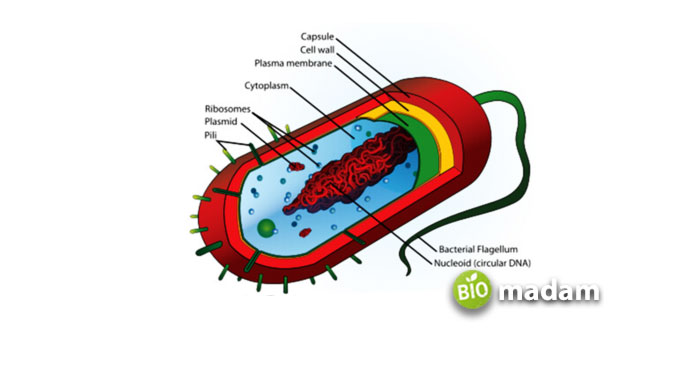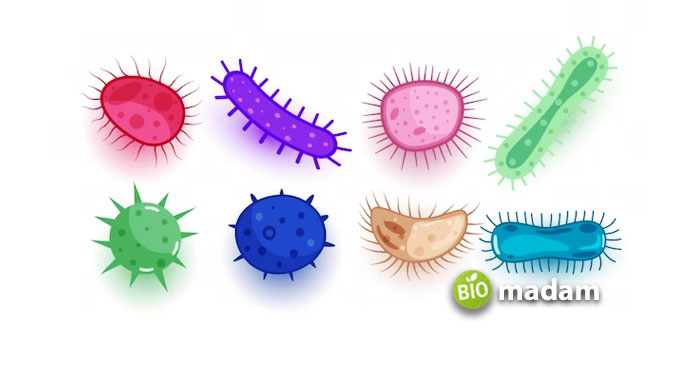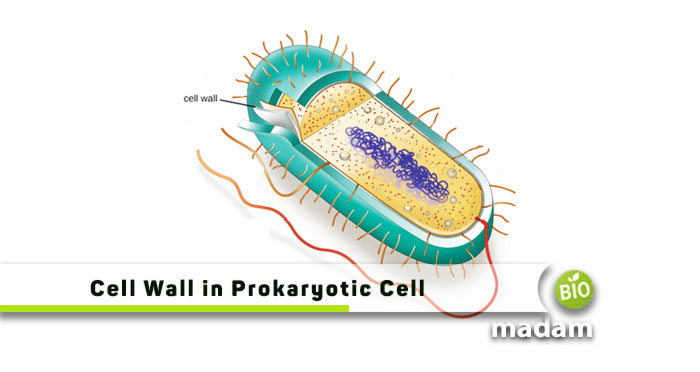Microorganisms and organisms are divided into two main classifications, called prokaryotes and eukaryotes. Prokaryotes are comparatively simpler organisms that are unicellular and lack membrane-bounded organelles or complex structures. Although they lack a distinct nucleus, prokaryotes still have a single chromosome to perform genetic functions. Not all, but most of the prokaryotes are covered with a cell wall, performing several vital functions.
Let’s first go through its structure in detail, and then we will move toward the structure and function of the cell wall in the prokaryotic cell.
Structural Components of Prokaryotic Cell
Prokaryotes are broadly classified into two domains, Bacteria and Archaea. Typical structural components in these microorganisms are:
- Cell Wall: It is a rigid structure surrounding the plasma membrane. The cell wall of prokaryotes generally provides shape and support to the cell and protects it from external stressors.
- Capsule: Most bacterial cells have an outer protective covering besides the cell wall known as a capsule. This structure helps in moisture retention and the attachment of bacterial cells to other surfaces and nutrients.
- Plasma Membrane: A thin, semi-permeable membrane surrounding the complete cytoplasm of a cell is called the plasma membrane. The plasma membrane of some prokaryotes, like cyanobacteria, plays a crucial role in maintaining cellular processes, such as photosynthesis and cellular respiration.
- Cytoplasm: It is a gel-like substance that is filled in the entire prokaryotic cell, including bacteria. A bacterial cytoplasm contains its other structural components, like nucleoid region, ribosomes, and plasmids.
- Ribosomes: Just like eukaryotes, prokaryotes also have ribosomes, but smaller in size. These ribosomes are responsible for protein synthesis.
- Nucleoid Region: Despite lacking a distinct nucleus, prokaryotes still have a nucleoid region. Here, the circular chromosome containing DNA is present, dispersed in the specified region.
- Plasmids: Plasmids are small, circular pieces of DNA, and prokaryotes have a lot of them. Plasmids may contain genes that provide the cell with extra capabilities, such as antibiotic resistance.
- Pilli: These are short, hair-like components present on the prokaryotic cell surface. Pilli has an important role in bacterial cells as they facilitate the microbe to adhere to other surfaces and spread infections or diseases.
- Flagella: Many prokaryotic cells, such as bacteria have flagella, which are whip-like structures that help in locomotion.

Prokaryotic Cell Wall and its Composition
The outermost covering of a prokaryotic cell is its cell wall, which is sometimes surrounded by a capsule. The cell wall is generally composed of carbohydrates and proteins. Most of them are peptidoglycan, where the short peptide chains are attached to muramic acid or murein. As discussed, the prokaryotes are broadly divided into bacteria and archaea, so the cell wall composition in both varies a little.
Bacterial Cell Wall Composition
The function of the cell wall in a bacterial cell is similar to that of archaea, but it differs in containing peptidoglycan. The peptidoglycan wall (PG) usually consists of glycan chains of the repeating N-acetylglucosamine and N-acetylmuramic acid residues that are connected via peptide chains.
Bacteria are either gram-positive or gram-negative depending on their response to gram staining. These variations in the bacterial responses to staining are actually due to the difference in cell walls of gram-positive and gram-negative bacteria. The Gram-positive bacteria have a thick layer of peptidoglycan, whereas Gram-negative bacteria contain thin layers of it. Contrary to gram-positive bacteria, the peptidoglycan in gram-negative is only 10 percent of the total cell wall. It is further covered with an outer envelope enriched with lipopolysaccharides and lipoproteins.

Archaeal Cell Wall Composition
Like eubacteria, the archaea also contain a cell wall for specified functions. These are composed of various complex molecules and compounds, including glycoproteins, S-layer proteins, and pseudo peptidoglycan. Be it any type of archaeal cell wall, the primary function is to provide strength and shape to the organism. Pseudopeptidoglycan, also called pseudo-murein, is similar in structure to bacterial peptidoglycan but differs in the type of sugar. The main components of this type of archaeal cell wall are N-acetylglucosamine (NAG) and N-acetyltalosaminuronic acid (NAT).
Similarly, another critical component of the archaeal cell wall is the S-layer protein that forms a crystal lattice structure to protect the microorganism. The S-layer proteins are pretty diverse so they differ with different archaeal species. In addition to these, some archaea use glycoproteins to strengthen their cell walls. They play a significant role in maintaining the cell shape and protecting it from the external environment.
Functions of the Prokaryotic Cell Wall
Now that we know, the cell wall is a rigid layer that mainly functions to surround the cell membrane and protect it from outside stresses. The following are the essential functions of the prokaryotic cell wall:
Structural Support
The complete shape of a prokaryote is due to the cell wall surrounding it. The cell wall provides a definite shape to the microorganism. It prevents the cell from collapsing or bursting due to changes in osmotic pressure as well.
Regulation and Permeability Control
The prokaryotic cell wall also regulates the passage of molecules entering or going out of the cell. These structures help in controlling and allowing the molecules to enter while blocking the rest to spread the disease.
Provides Protection
The primary function of a cell wall in any cell is to provide physical protection. This outer, rigid layer shields the prokaryote from environmental factors, such as exotoxins, osmotic shocks, or antibiotics.
Providing Support to Surface Appendages
Most prokaryotes have surface appendages on them, such as flagella and pili. The flagella in prokaryotes typically help in bringing motility, whereas pili help in strengthening attachment to the cell. The prokaryotic cell wall provides an anchor to these structures so they can properly function.
The Bottom Line
Just like the difference in hereditary materials of the prokaryotes and eukaryotes, the cell wall of both varies. The composition of the cell wall in plants is different from fungi and bacteria. A plant cell wall is a large polymer of polysaccharide, while a fungal cell wall is made up of chitin. Just like that, prokaryotes have a different composition. Despite all these variations, the main function of the cell wall is the same in all. It is primarily present to provide support to the cell.
FAQs
What is the largest prokaryotic cell?
The largest prokaryotic cell known till now is the Thiomargarita namibiensis, which is a gram-negative coccoid bacterium. It was first discovered in the late 1990s near the coast of Namibia.
Are cell walls only present in prokaryotes?
All prokaryotes consist of external support through rigid layers called cell walls, but these are not the “only” cells containing cell walls. Besides prokaryotes, all eukaryotic cells also attain this structure.
Which prokaryotic organism doesn’t has a cell wall?
Mycoplasma is the smallest prokaryotic organism that lacks a supporting cell wall. However, these bacterial cells have rigid cell membranes enriched with lipoglycans and sterols.
Is the archaeal cell wall gram-positive or gram-negative?
Most of the archaeal cell walls are observed to be gram-negative; however, this is not the pet statement. The criteria by which a bacterial cell is categorized into gram-positive or gram-negative is the structural and chemical composition of the surrounding layer.
Can prokaryotes survive without a cell wall?
In specific conditions, prokaryotes like bacteria can survive without a cell wall. In these situations, these organisms retain their ability to withstand the environment through their tough cytoplasmic membranes.

Anna has completed her degree in Pharmacy from the University of Hawaii. She is serving as a research assistant in a pharmaceutical company. She had a great interest in writing blogs, traveling to different parts of the US, and trying delicious recipes in her spare time.

